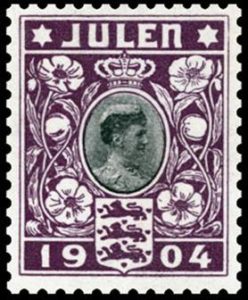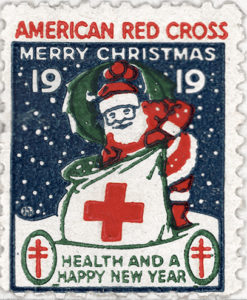In the early twentieth century, the American Red Cross played a role in the fight against tuberculosis with Christmas seals. Before the introduction of antibiotics in the 1940s, tuberculosis or TB was one of the deadliest killers. No one was immune from the disease. The only treatments known to work were rest, proper nutrition and “clean” air at sanatoriums or special hospitals located in rural areas.
Supporting the sanatoriums was costly and in 1904, Denmark introduced the first Christmas seal as a way to raise money. Seals were sold for a penny each and the proceeds went to support the care of TB patients.

1904 Seal from First Campaign in Denmark
Artist and Lithographer: Alfred Jacobsen
Private Collection
By 1907, the Christmas seal idea spread to the United States and Emily Bissell, secretary of the American Red Cross Delaware Chapter learned of the idea and wanted to use it to help a struggling local tuberculosis sanatorium. The 1907 seal shows a wreath of holly surrounding the familiar greeting “Merry Christmas.”‘
1907, Artist: Emily P. Bissell, 1861-1948
Lithographer: Theodore Leonhardt & Son
Funds raised: $ 3,000
Two days after the first supply went on sale more than 30,000 were sold and a new supply was needed. Since the Wilmington, Delaware printer was swamped, one from Philadelphia was chosen. The distance between the two cities caused a delay in getting the Christmas Seals printed in time for the holiday. Adding the words “Happy New Year” solved the problem.
Later, the American Red Cross further developed the idea as an annual, nationwide campaign, enlisting the talents of many of this nation’s best-known artists and illustrators. The program raised from $250,000.00 to over $3 million.
From 1910 to 1919, the American Red Cross worked with the National Tuberculosis Association on the Christmas seal program. By 1919, the last year of Red Cross participation, the seal featured both the red cross and the double barred cross of Lorraine used by the National Tuberculosis Association.
1919
Artist: Ernest Hamlin Baker, 1889-1975
Lithographer: Strobridge Lithographing Company
Funds raised: $3,872,533
By 1920, the entire program was run by the National Tuberculosis Association and continues today with its successor the American Lung Association.



